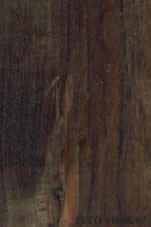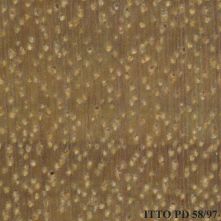
GRENADILLE AFRIQUE (Dalbergia melanoxylon)
Trade Name
Grenadille Afrique
Scientific Name
Dalbergia melanoxylon Guill. et Perr.
Family
LEGUMINOSAE
Common Names
Ebene (Senegal); African Grenadillo (United Kingdom); Afrikanisches Grenadill (Germany); Umbambangwe; Tareh; Shami; Senegal ebony; Samachi; Rugbe; Rit; Red; Poyi; Pingo; Opo; Murwiti; Munhowe; Mumhingwe; Mukudziti; Muhati; Mugweze; Mufulamamba; Mozambique ebony; Motangu; Lurr; Funiti; East African blackwood; Driedoring; Did; Chiku; Chella; Cape damson; Bokango; Black botany bay wood; Begboio; Babanus; African ebony; Afrikanisches grenadille (Germany); Ebene du mozambique (France); African grenadillo African grenadillo (United Kingdom); African blackwood (United Kingdom); Mukelete (Zimbabwe); Banbanus (Sudan); Mufunjo (Uganda); Mpingo (Tanzania); Grenadilla (Mozambique); Pau-Preto (Mozambique); Mukelete (Reunion); Mugembe (Tanzania); Grenadille Afrique
Scientific Name Synonyms
Amerimnon melanoxylon (Guill. & Perr.) Kuntze
Description Of The Tree
Botanical Description
The tree is much branched, usually multi-stemmed and small, 5 to 8 m in height, sometimes as much as 16 m. The bole is short, cylindrical, often fluted and rarely over 30 cm in diameter.
Natural Habitat
Dalbergia melanoxylon occurs on a wide variety of sites from sea level to 1,050 m of altitude.
Natural Distribution
East and Central Africa, from Sudan to Mozambique, to Angola, and to Senegal.
Non Timber Uses
Contains some resins or extracts which could pose problems when machining or finishing.
Wood Identification
Anatomic Description Of Wood
Wood semi-ring porous and/or ring porous. Occasionally vessels exclusively solitary (over 90%). Tangential diameter of vessel lumina 100 to 150 micras (small). Brown-colored deposits in heartwood vessels. Vestured pits. Vessels per mm2 more than 20 (very abund Axial parenchyma in marginal or in seemingly marginal bands. Apotracheal axial parenchyma diffuse and/or diffuse in aggregates. Paratracheal axial parenchyma scanty and/or vasicentric. Axial parenchyma storied. Prismatic crystals in short chains in chambered Rays more than 10 per mm (abundant). Rays storied. Rays 1 to 2 seriate. Homogeneous rays and/or sub-homogeneous rays (all ray cells procumbent). Body ray cells procumbent with one row of upright and/or square marginal cells (Kribs-III). Non-septate fibers. Fibers with simple to minutely bordered pits.
-
 Wood Macro Photo Tangential Plane
Wood Macro Photo Tangential Plane
-
 Wood Micro Photo Of Transversal Section
Wood Micro Photo Of Transversal Section
Availability
Cites Status
Unrestricted
General Wood Description
Color
The sapwood is yellowish white. The heartwood is dark purple-brown with black streaks, it is sharply demarcated.
COLOR INDEX (1=Black, 7=Light yellow,white)
1
Grain
Straight; grain has no particular influence on drying, machining and finishing qualities.
Texture
This wood has a somewhat fine texture.
Natural Durability
Very durable to decay; without preservative treatment. This species is especially suited for all the uses with risks of permanent or long-lasting humidification. Resistant to termites attack. Heartwood is resistant to Lyctus attacks.
Natural durability index (1= Very high durability, 7=Vey low durability)
1
Internal Growth Stresses
No growth stresses are reported in this species.
Resistance To Impregnation
Nearly impossible to treat with a too much low penetration of the preservative substances.
Wood Physical Properties
Basic Density or Specific Gravity (O.D. weight/vol. green) (g/cm³)
1.07
Air-dry Density (Weight and volume at 12%MC) (g/cm³)
1.29
Drying Defects
Ease of Drying: Air seasoning of Resak is reported to be moderately slow. Boards of 25 mm thick take about 2.5 months to dry from 35% to 15% moisture content. Drying Defects: Risk of warping, checking and deformation.
Recommended Dry Kiln Schedule
FR-13
Wood Chemical Properties
Wood Mechanical Properties
Bending Strength (MOR),12%MC (kgf/cm²)
1650
Stiffness (MOE) 12%MC (kgf/cm²)
206458
Compression parallel to fiber 12%MC (kgf/cm²)
729
Compression perpendicular to fiber 12%MC (kgf/cm²)
103
Janka hardness (side) 12%MC (kgf)
2123
Janka hardness (end grain) 12%MC (kgf)
1903
Workability
Sawing
Sawing of this species requires powerful equipment.
Rotary Veneer Cutting
Not suitable for veneering.
Sliced Veneer
Not suitable for veneering.
Blunting Effect
Severe blunting effect; stellited blades for sawing and carbide tools for machining are recommended.
Machining
It needs powerful tools for processing. Possible difficulties caused by interlocked grain are reported.
Planing
Rather difficult; special tools are needed.
Moulding
Moderately easy; tools must be cautiously sharpened.
Boring
Moderately easy; tools must be cautiously sharpened.
Mortising
Moderately easy; tools must be cautiously sharpened.
Nailing
Pre-boring is necessary.
Gluing
Difficult to glue because of the extracts content.
Sanding
Easy to perform; it gives good results.
Polishing
Can be polished without surface preparation.
Response To Hand Tools
Working with hand tools is difficult.
REFERENCED USES
End Uses Summary
HOUSING GENERAL, fittings, FURNITURE AND CABINETS
General Housing
- 10 - Silica in Timbers
Fittings
- 19 - Silica in Timbers
Furniture Cabinets
- 21 - Tropical timbers of the world. Part III-Southeast Asian and Oceanian Species.
Please Provide Information To View Producer Information